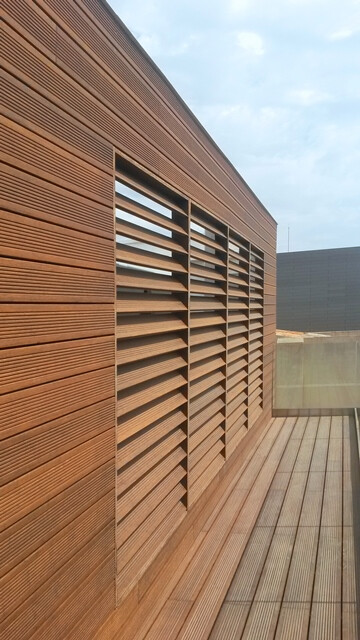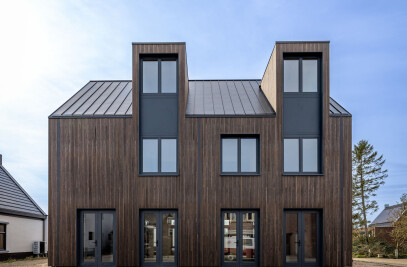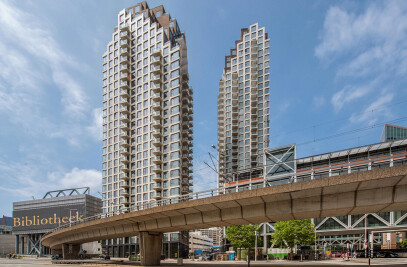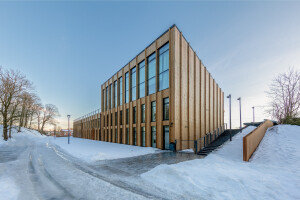The facade is the business card of every building and the design and material used is very decisive for the appearance. Bamboo is a durable material that is suitable as façade covering, especially if a natural look is desired. Bamboo wall cladding for outdoor use is available in the form of cladding boards or beams. MOSO® offers several solutions for this purpose within the Bamboo X-treme® range.
Bamboo offers several benefits over other cladding materials: its natural appearance; a high stability and hardness; fire resistant properties of the material reach fire class B-s1-d0 (EN 13501-1); CO2 neutral MOSO® Bamboo Products contribute to sustainable building, including extra credits for LEED and BREEAM building certification.
Sustainable and renewable
Bamboo is the fastest growing plant on this planet (up to 1 meter per day!) and is an abundantly available building material. Almost all solid MOSO® Bamboo Products have a negative carbon footprint during the product lifespan and are therefore the sustainable alternative to non-renewable materials and scarce tropical hardwood.

Thermally treated bamboo cladding
Bamboo X-treme® is the most widely used exterior material in bamboo. More than 10 years after its introduction, the material has proven to be very durable and easy to maintain. Due to the Thermo-Density® production process, bamboo boards are preserved. The cladding boards can be installed untreated as building façade and require no finishing or maintenance. Bamboo X-treme® grays naturally and is extremely stable, which means that the boards remain nice and straight. Among the technical properties of Bamboo X-treme® cladding, the fire class B-s1-d0, use class 4 (EN 335) and durability class 1 (EN 350 tested according to CEN/TS 15083-2) are particularly appreciated.
MOSO has developed a unique thermal treatment and compression process to alter the hardness, dimensional stability, fire safety and durability of its bamboo boards to a level superior to the best tropical hardwood species. Because of the high stability the decking boards come standard with headside tongue and groove, even for the widest boards (178 mm), and they can be mounted on walls and terraces with low tolerances and no dilatation seams between headsides necessary. Because the decking and cladding boards are made using the same process it is now possible to have the same color for a continuous look from horizontal terrace to exterior vertical wall.
MOSO Bamboo X-treme cladding
MOSO Bamboo X-treme cladding is a solid, high density exterior bamboo board, made from compressed bamboo fibers. A special, patented heat treatment/compression process provides Bamboo X-treme the highest durability class possible in the appropriate EU norms,increases the stability and density, and consequently the hardness (see all technical characteristics below). Furthermore, contrary to other wood products this product reaches fire safety class B-s1 d0 (EN 13501-1) without impregnation with expensive and eco-damaging fire retardants. Bamboo X-treme cladding is available in 2 versions which can be installed with clips and/or with screws.
Natural façades with bamboo beams
The Bamboo X-treme® range offers not only cladding boards but also beams in different dimensions. The beams can be installed in various forms as cladding. The creativity of the architect and the quality of the installation work determine the final beauty of the façade. The Bamboo X-treme® beams age naturally and are very stable, keeping them nicely straight and level.
From bamboo stem to cladding
After harvesting, the mature bamboo stems are split in a longitudinal direction and the outer and inner skins are removed. The strips are then crushed using a number of incision rollers which create cross linked strands. The untreated strands are a light yellow color.
In several steps, the strands are heated up to 200°C in the presence of saturated steam (to protect the wood from charring or burning) and cooled down. During thermal modification, the moisture content changes and the sugar content is removed from the material. Furthermore, this process changes the color of the bamboo from white/yellow to deep/dark brown.
The dark bamboo strands are dipped into phenolic glue (< 10% of the weight of the bamboo). After drying, the strands are put into a mold, and are then compressed under high temperature and pressure to cure the glue. The output is a large panel, which is cut into smaller sections (boards or beams). These are then further processed and profiled to become the required shape (for example, for decking: a grooved surface and edge grooves to allow installation with fasteners). As a last step, depending on the customer’s request, the boards can be finished.

A European market leader
Moso International was founded in 1997 and has since then evolved to become the unchallenged European market leader in the development of innovative and sustainable bamboo products for interior and exterior applications.
Reference Projects
Two residential towers designed by MVRDV have been completed in The Hague. Grotius Towers, which are 120 and 100 metres tall, are located on Grotiusplaats, a stone’s throw from the city’s Central Station and alongside the Royal Library of the Netherlands. At their tops, the Grotius Towers become a landscape of setbacks and terraces. These crowns are visible from afar, making an eye-catching new addition to the skyline of The Hague. A change in colour and material gives the crowns an extra accent, as they change from gray stone at the base floors to bamboo cladding by MOSO on the terraces and the upper facades.
Two semi-detached homes were built to be as sustainable, circular and future-proof as possible. The client, a starting contractor, wanted to revolutionize the traditional construction process by using eco-friendly materials and innovative methods. The facades have a strong vertical articulation due to their composition and their materialization in open bamboo cladding with invisible attachments. The asymmetrical facade layout contributes to the volume’s dynamic appearance. Sustainability is central to the design and biobased materials with the lowest possible environmental impact were used where possible. The construction phase of the project was calculated to be carbon negative.
The leisure space is developed on a plot of steep incline under the slope of the old railway, in a municipality near Burgos, Spain. The pavilion, the most outstanding element of the program, is located in the highest part of the plot to allow views towards the south of the other spaces and the urban environment. A cladding of bamboo boards used both in the dihedral of the pool and in the volume of the dining room. In the latter, the two large gaps that allow a complete connection of the space with the plot and the environment can be completely hidden with two sliding elements of the same cladding.
Apartment blocks De Drie Hofsteden
Commissioned by a social housing company, the two existing apartment blocks in the Drie Hofsteden in Courtrai have been thoroughly renovated. At the same time, a third apartment block was built. This renovation project is partly a component of an ECO Life project with European subsidies. The ambition level for the new construction results in low energy consumption. In order to give the project a natural look, MOSO® Bamboo X-treme® was selected for finishing the façade of the new building. The ecological advantages of the CO2 neutral bamboo cladding fit in very well with this project.





























